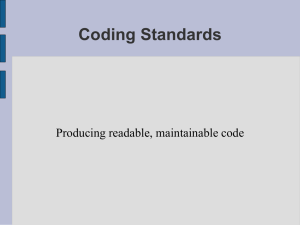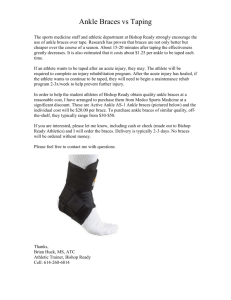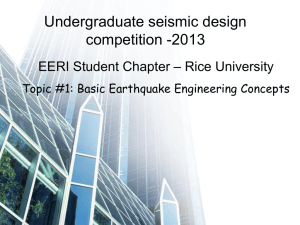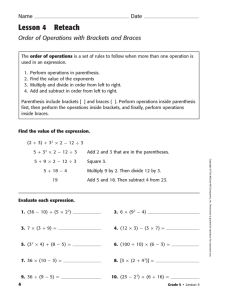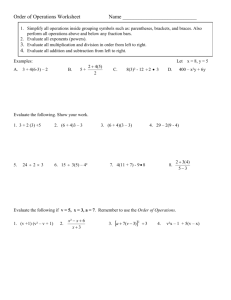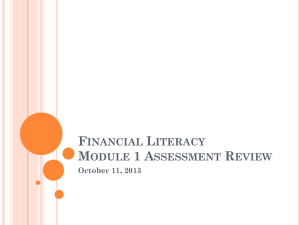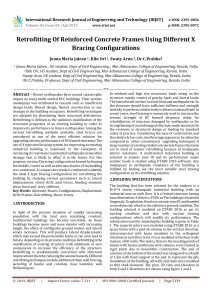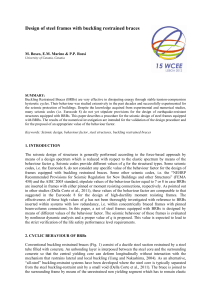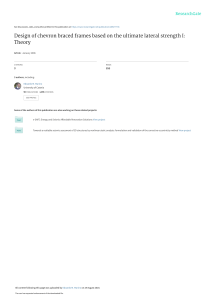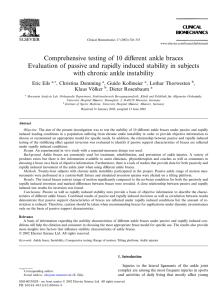Document 10750633
advertisement
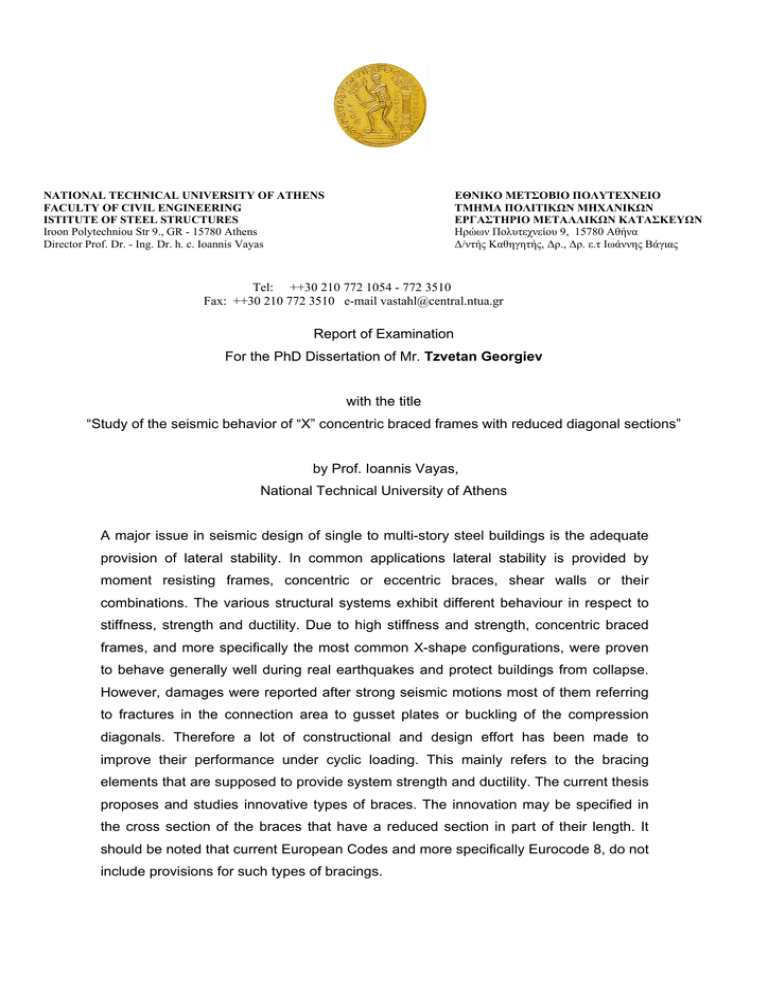
NATIONAL TECHNICAL UNIVERSITY OF ATHENS FACULTY OF CIVIL ENGINEERING ISTITUTE OF STEEL STRUCTURES Iroon Polytechniou Str 9., GR - 15780 Athens Director Prof. Dr. - Ing. Dr. h. c. Ioannis Vayas ΕΘΝΙΚΟ ΜΕΤΣΟΒΙΟ ΠΟΛΥΤΕΧΝΕΙΟ ΤΜΗΜΑ ΠΟΛΙΤΙΚΩΝ ΜΗΧΑΝΙΚΩΝ ΕΡΓΑΣΤΗΡΙΟ ΜΕΤΑΛΛΙΚΩΝ ΚΑΤΑΣΚΕΥΩΝ Hρώων Πολυτεχνείου 9, 15780 Αθήνα Δ/ντής Καθηγητής, Δρ., Δρ. ε.τ Ιωάννης Βάγιας Tel: ++30 210 772 1054 - 772 3510 Fax: ++30 210 772 3510 e-mail vastahl@central.ntua.gr Report of Examination For the PhD Dissertation of Mr. Tzvetan Georgiev with the title “Study of the seismic behavior of “X” concentric braced frames with reduced diagonal sections” by Prof. Ioannis Vayas, National Technical University of Athens A major issue in seismic design of single to multi-story steel buildings is the adequate provision of lateral stability. In common applications lateral stability is provided by moment resisting frames, concentric or eccentric braces, shear walls or their combinations. The various structural systems exhibit different behaviour in respect to stiffness, strength and ductility. Due to high stiffness and strength, concentric braced frames, and more specifically the most common X-shape configurations, were proven to behave generally well during real earthquakes and protect buildings from collapse. However, damages were reported after strong seismic motions most of them referring to fractures in the connection area to gusset plates or buckling of the compression diagonals. Therefore a lot of constructional and design effort has been made to improve their performance under cyclic loading. This mainly refers to the bracing elements that are supposed to provide system strength and ductility. The current thesis proposes and studies innovative types of braces. The innovation may be specified in the cross section of the braces that have a reduced section in part of their length. It should be noted that current European Codes and more specifically Eurocode 8, do not include provisions for such types of bracings. The thesis is structured in five chapters as discussed in the following.. Chapter 1 introduces the objectives of the thesis and presents the state of the art in respect to research and Codification. It briefly discusses experimental and theoretical investigations on the seismic performance of X-braced frames with conventional bracings, focusing on the behavior of the bracings themselves as well as the gusset plates and the connections at ends and the point of intersection. It also discusses innovative bracing elements like buckling restrained braces (BRB) and braces with dissipative (INERD) connections. It then analyses the composition of the behavior factors and correctly declares ductility and overstrength as the most important properties for seismic safety. It reviews and compares the provisions of European and US Codes for such types of frames. It then presents the two innovative bracing elements with reduced section near the bracing ends or correspondingly at mid-length. It argues that the proposed configuration is supposed to possess higher ductility than conventional systems. Additionally overstrength may be improved by appropriately tuning the cross section reduction in order to evenly distribute yielding of the braces over the building’s height. Chapter 2 investigates the response of reduced section braces to tension – compression under static loading. It introduces various shapes of reduced sections and studies analytically and numerically by means of Finite Elements the influence of the reduction in cross section and the length of the reduced part on the kinematics of the frame and the capacity and the deformation capacity of the tension element. Subsequently it studies the response of the compression diagonals and defines an equivalent slenderness for members with reduced section. The above investigations aided at finding advantageous dimensions for the reduced cross sections in order to proceed with the experimental investigations in the next chapter. Chapter 3 presents the experimental investigations of the new system. They were performed on isolated elements and subsystems that were subjected to cyclic loading with loading protocol as defined by the relevant European ECCS Recommendations. Overall 6 cyclic tests were performed. The two first tests refer to an isolated brace element. The full cross section of the brace is an H-shape. The reduced section results in from reduction of the flange width and providing a slot in the web over a certain length at the ends. Tests 3, 4 and 5 refer to a single story one bay X-braced frame using the scaling factor of approximately 2. An intermediate transverse beam is introduced at mid-height in order to avoid direct crossing of the braces and relevant constructional difficulties and provide lateral stiffness at mid-height. It should be said that the studied geometrical proportions reflect configurations for single storey industrial buildings. However, a similar configuration may be introduced in multi storey buildings where the braces extend over two stories. The intermediate beam is then the floor beam. The cross section reduction in tests 3 and 4 was as in tests 1 and 2, while in test 5 only the beam flange and not the web was reduced and this was done around mid-length of the brace and not at its ends. In all tests the braces buckled at the region of the reduced section accumulating high strains. This resulted in finally low cycle fatigue and, for tests 3 and, 4 rapture of the brace at the reduced section. However in test 5, where the web was not reduced, no such rupture was observed indicating a better performance. Finally, test 6 refers to the frame without braces, i.e. an unbraced frame with low stiffness and strength. Chapter 4 presents the analysis of the tested frames. An analytical bi-linear model is proposed that may be used to model this type of braces in non-linera static (pushover) analyses. The model is calibrated on the experimental results and reflects very well the observed brace behavior. Subsequently for all tests the strength ratios, ductility ratios and energy absorption ratios at various storey drifts were determined. This was followed by the determination of the frame ductility factors, the overstrength factors and finally the experimentally observed behavior factors. The latter were found a little larger than those provided by Eurocode 8, indicating a better performance of the proposed braces to conventional ones during seismic loading. Chapter 5 concludes the thesis and gives recommendations for practical applications. It then reports the main scientific contributions of the author. The thesis examines an innovative system that has a great potential for applications for braced structures in single and multi storey steel buildings. To study its behavior under severe seismic conditions, extensive experimental, analytical and numerical investigations have been performed. All was done using latest state of the art experimental and numerical tools. The studies showed the capacity of the system for the applications envisaged. Recommendations are included that allow the Engineer to pre-dimension, analyze and verify the structure. In fact two configurations were examined. The original one used a reduced cross section at the ends of the braces where all inelastic deformations concentrated. The reduction concerned both the cross section flanges and the web. The cuts in the web formed two short columns in the reduction area that were prone to instability in the form of flexural buckling. The instability resulted in a reduction of system ductility and leads to fracture at brace ends. In order to remove this drawback, a modified design was proposed in which only the flanges, but not the web were reduced. The reduction in the modified design was done at the middle of the braces and not at the ends. This reporter believes that this configuration, and possibly a similar one but with reduction at both brace ends, is more promising than the original one. The capacity of the candidate to perform scientific research is herewith acknowledged. This reviewer therefore confirms the admissibility of this work as a PhD thesis and recommends its acceptance. Prof. Dr.-Ing. Ioannis Vayas
